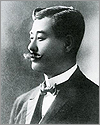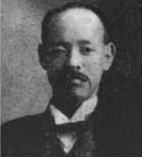1906
4 July
The doctrine of Nanshin-ron (Southern advancement theory) developed from the late nineteenth century initially as a peaceful economic advance into the Pacific region, not territorial gain through aggression (Post : 63). Stimulated by the victory in the Russo-Japanese war, Japan emerged confident to take up leadership of the Far East. In 1936 Nanshin-ron became official policy and provided the Japanese military government with an ideological justification for its aggressive territorial expansion into the South East (Shimizu : 388). Imamura Shohei gives a satirical interpretation of Japanese expansionism in South East Asia at the turn of the century in his black comedy Zegen (1987). The film follows Muraoka Iheiji's, loosely based on his own autobiography edited by Kawai Yuzuru in 1960, patriotic crusade of procuring Japanese prostitutes to open a chain of brothels across the European colonies in Southeast Asia spearheading his country's own colonialist ambitions. These prostitutes working overseas, commonly called karayuki-san, were acknowledged, though with the alternative and more approving term roshigun, as the advance guard of Japanese overseas expansion playing a leading role in promoting Japan's business presence in the region (Mihalopoulos :51). Their presence in major business hubs of the South East highlighted the Japanese government's willingness to allow prostitution to drive the country's economic expansionist process .
Among the many Japanese who built up successful businesses in Asia around this time were also film entrepreneurs such as Takamatsu Toyojiro, seen as one of the key figures in Taiwan's early cinema. Takamatsu arrived in Taiwan in 1903 bringing to the Japanese colony his popular travelling film show which he began in Japan at the turn of the century. In 1907 he produced Taiwan's first film, an educational documentary titled Taiwan Jitsukyo no Shogai (An Introduction to Taiwan's Reality). It was shot in more than one hundred locations and included a variety of subjects such as urban construction, railway, agriculture and the lifestyle of aborigines (Lin : 143-44). During his business career he also built a total of eight theaters in different cities of the island and even established an acting school in 1909 (Hong : 18-19). Film historian Tanaka Junichiro cites other Japanese working in overseas film businesses like cinematographer Fujiwara Kozaburo or the rubber plantation owner Watanabe Jisui, also known as Watanabe Tomoyori (Barmé : 45). After filming the Russo-Japanese conflict for Yoshizawa Shoten, Fujiwara settled in Beijing and open either a cinema (Tanaka, 1980: 130) or a photo studio (Tanaka, 1979 : 20), postponing his return to Japan until the opening of Nikkatsu's Mukojima film studio in 1913. On the other hand, Watanabe pioneered film exhibition and production in Thailand. In the latter half of 1904 he returned briefly to Japan where he witnessed the enormous popularity of Russo-Japanese war related film works. He purchased some, as well as others featuring geisha dances, street and scenery shots or a game of kemari (Barmé : 44-45), from Yoshizawa Shoten, and, helped by the shop's own projectionist Kayama Komakichi, began to show them first in Bangkok and later in the Strait Settlements, Borneo and Sarawak (Tanaka 1980 : 120 ) and (Barmé : 60). In 1905, Watanabe opened the first permanent theater in Thailand, the Japanese Cinema, called later the Royal Japanese Cinematograph after being granted royal permission to display the government seal. Also in the same year traveling film exhibitor Komada Koyo's company, Nihon Sossen Katsudo Shashin Kai (Pioneer Japanese Motion Pictures Association, traveled all the way to Hong-Kong and opened a cinema at 14 Des Vooeux Road to show films about the Russo-Japanese War (Law 2017 : 127) (Lee 2017 : 132).
But perhaps the most important and influential of these Japanese émigrés in the development of their national cinema was Umeya Shokichi(1), who since 1893 had been running a photo studio for a year in Singapore and later, for almost a decade, in Hong-Kong. During this period he had collected films mainly from the French Pathe and organized very popular showings in Singapore after his second arrival in the British colony in May 1904. Before Umeya, a certain Matsuda had been showing movies outdoors (Hui : 50). Around 1905 he met Harima Katsutaro, owner of the Harima Hall on North Beach Road, who had previously collaborated with Watanabe in film exhibition in Thailand. Once in Japan, and without authorization, he borrowed the name of the world largest film producer at the time and founded his own film company, M Pathe (M standing for the old rendition of his surname in Latin script or roma-ji MUMEYA), which Tanaka Junichiro sets in 1906, whereas Richie and Anderson (28) the previous year (2). This discrepancy is particularly significant since it has often been argued that Richie and Anderson's pioneering work in English borrows heavily from Tanaka's (Kirihara : 507). Umeya's main biographers Kurumada Joji (177) and Kosaka Ayano (89), Umeya's own great granddaughter, mark his arrival back in his hometown of Nagasaki in 1905, aged 36, where he gave a preview of his films at a local theatre. Umeya "burst upon the Tokyo film promotion scene", however, did not take place in July 1905 as stated by Peter B. High (105), perhaps taking as reference the date suggested by Kurumada (177) , but the following year as claimed by Tanaka citing a flyer that appeared in the Yomiuri Shinbun on 3 July 1906 promoting the lavish film venue organized by Umeya at the Shin Tomiya-za theatre. This film show ran from the 4th to the 13th and among the films shown was a tinted version of Ferdinand Zecca's La Vie et la Passion de Jesus Christ (1903), which he had already exhibited in Singapore (Tanaka 1980 : 150).
- His figure has recently seen a revival particularly since 2011 which marked the centenary of the Xinhai Revolution which Umeya, through one of its leaders Sun Yat-sen (Son Bun in Japanese), financially supported with his photography and film business adventures over a period of twenty years. Thus a year earlier on May 22 the channel BShi (now BS Premium) of the public broadcaster NHK aired an 89-minute documentary about him (available on YouTube) titled SON BUN SASAETA NIHONJIN - SHINGAI KAKUMEI TO UMEYA SHOKICHI-. On February 26 2014, TV Tokyo broadcast the special drama TATTA ICHIDO YAKUSOKU (Just One Promise) starring Yanagiba Toshiro in the role of the maverick impresario. Between October 6 to November 25 2018 the Museum of History and Culture in his hometown of Nagasaki held the exhibition Eigakai Fuunji Mumeya Shokichi (Mumeya Shokichi - a pioneer in the Japanese film industry) to commemorate the 150th anniversary of his birth. Finally, in April 2020 the public broadcaster NHK aired a 3-episode drama with the title GEKITO! CHUGOKU KAKUMEI NI KAKETA NIHONJIN - SON BUN TO UMEYA SHOKICHI.
- Umeya's biographer Kurumada Joji also dates the founding of M Pathe in 1905 (183).
Sources:
Anderson, Joseph L. and Richie, Donald, The Japanese Film: Art and Industry, Princenton University Press, 1982.
Barmé, Scot, Woman, Man, Bangkok: Love, Sex, and Popular Culture in Thailand, Silkworm Books, 2006.
High, Peter B. Umeya Shokichi: The Revolutionist as Impresario, Tagen Bunka to Mirai Shakai Kenkyu
Project, Nagoya University, 2004.
Hong, Guo-Juin, Taiwan Cinema: A Contested Nation on Screen, Palgrave Macmillan, 2011.
Hui, Tsu Yun, A Social History of the Japanese in Singapore to 1945, in Japan and Singapore: A Multidisciplinary Approach, edited by Timothy Tsu , Singapore,
McGraw-Hill Education Asia, 2006, 20-52.
Kirihara, Donald, Post-Theory: Reconstructing Film Studies in Reconstructing Japanese Film, edited by David Bordwell and Norl Carroll, Madison: University of Wisconsin
Press, 1996 , 501-19.
Kosaka, Ayano, Kakumei o Purodyusu Shita Nihonjin, Kodansha, 2009.
Kurumada, Joji, Kokufu Son Bun to Umeya Shokichi: Chugoku ni Sasageta Aru Nihonjin no Shogai, Rokko Shuppan, 1975.
Law, Wai-ming, Hong Kong's Cinematic Beginnings, 1896-1908 in Early Cinema in Asia edited by Nick Deocampo, Indiana University Press, 2017.
Lee, Daw-Ming, How Cinema Arrived and Stayed in Taiwan in Early Cinema in Asia edited by Nick Deocampo, Indiana University Press, 2017.
Lin, Pei-Yin, Translating the Other: On the Re-circulations of the Tale Sayonfs Bell, in China and Its Others: Knowledge Transfer through Translation, 1829-2010, edited
by James St. Andre and Peng Hsiao-yen, Rodopi Bv Editions, 2012: 139-164.
Mihalopoulos, Bill, The making of prostitutes: the Karayuki-san, Bulletin of Concerned Asian Scholars 25, 1: 41-57, 1993.
Post, Peter, Indonesianisasi and Japanization: The Japanese and the shifting fortunes of pribumi entrepreneurship, in Indonesian Economic Decolonization in Regional and
International Perspective, edited by J. Thomas Lindblad and Peter Post, KITLV Press, Leiden, 2009.
Shimizu, Hajime, Nanshin-ron: Its Turning Point in World War I, Developing Economies 25, no. 4: 386-402, December 1987.
Tanaka Junichiro, Nihon Kyoiku Eiga Hattatsushi, Kagyusha, 1979.
Tanaka, Junichiro. Nihon Eiga Hattatsushi - (1) Katsudo Shashin Jidai, Chuo Koronsha, Tokyo, 1980.
SON BUN SASAETA NIHONJIN -SHINGAI KAKUMEI TO UMEYA SHOKICHI-
TATTA ICHIDO YAKUSOKU
Eigakai Fuunji Mumeya Shokichi - (Mumeya Shokichi - a pioneer in the Japanese film industry)
GEKITO! CHUGOKU KAKUMEI NI KAKETA NIHONJIN - SON BUN TO UMEYA SHOKICHI-

(1868-1934)
